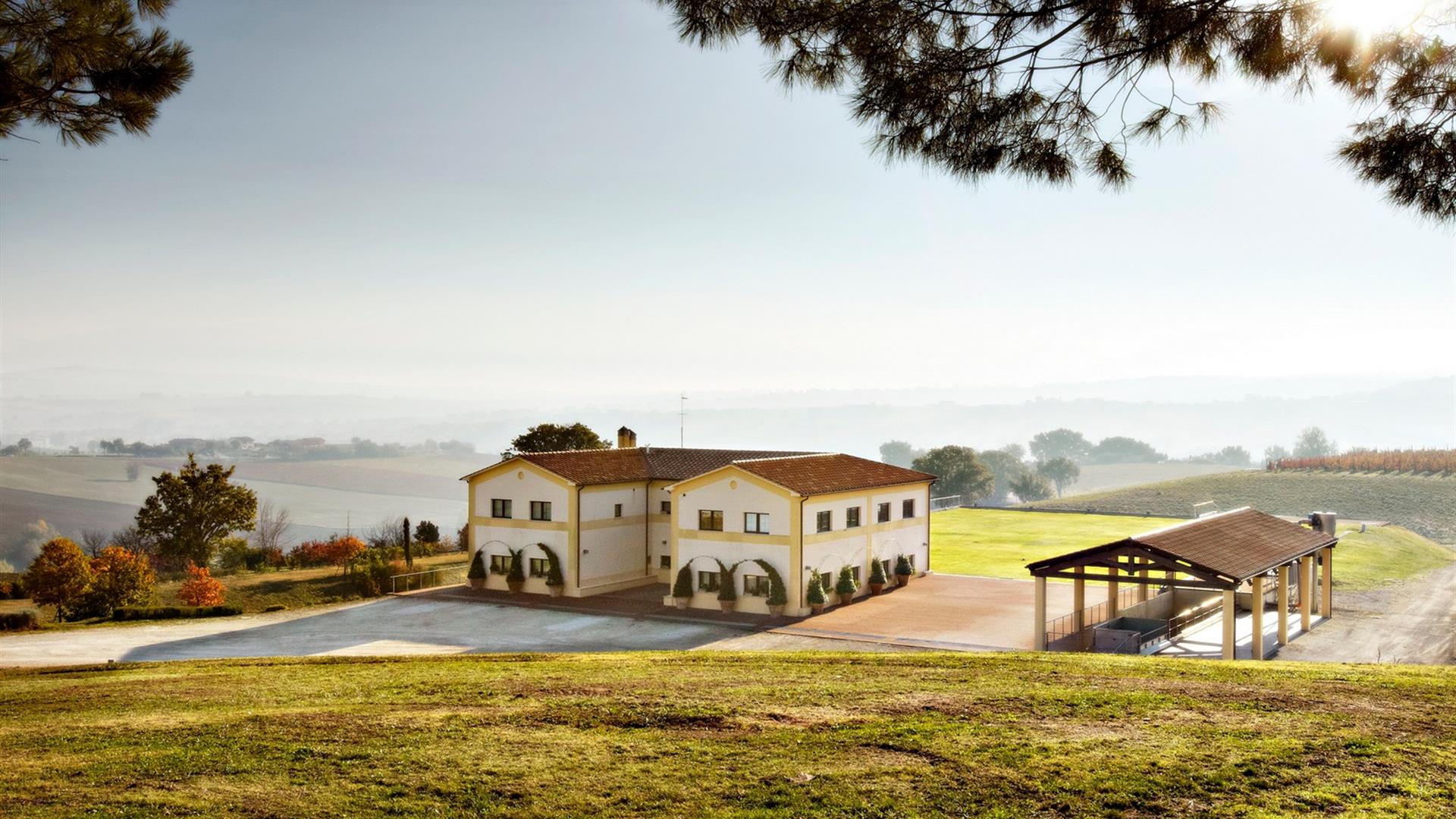A walk through Todi, a medieval town with intact charm
-
September 23, 2022min
Navigate to
- The history of Todi
- What to see in Todi: a walk in the town of good living
- The heart of Todi: Piazza del Popolo and its palaces
- The “Duomo” of Todi
- Doors and arches
- Temple of Santa Maria della Consolazione
- The Painted House and Beverly Pepper Park
- Todi and Its Panorama: The Best Places to Admire It
- Todi underground
- A journey through history, art and taste
The pearl or the terrace of Umbria. Indeed, “the most livable city in the world”, according to the architect and urban planner Richard Levine of the University of Lexington, who so defined Todi in 1991. Whatever you want to call it, you will understand that this town perched on a gentle hill, with an enchanting view on the surrounding countryside and a rich and ancient history, it represents an essential stop for those who want to discover the more authentic and less touristy Umbria.
But what is really worth seeing in Todi? Where can you find the best spots to admire its stunning views? We’ll take you on a tour through the streets of this little gem, full of surprises waiting to be discovered!
The history of Todi
It is located in the heart of Umbria, about forty kilometers from Perugia and close to the splendid Orvieto and the villages of Spello, Foligno and Montefalco. Perched atop a hill about 400 meters above sea level, the medieval town overlooks the Tiber Valley. A strategic position, which allowed Todi to play important defensive roles in the past, especially in the Etruscan and Roman times. In fact, it seems that the city was built by the Etruscans between the third and first centuries BC, a period to which also dates the first large circle of external walls, and that it then obtained the title of Roman municipality subsequently experiencing an important urban development-architectural.
But it is in the Middle Ages, starting from the 13th century, that Todi prospered and assumed the physiognomy we know today: the city walls widen, reaching to embrace the two surrounding spurs to the north and south, delimited by the monumental entrances of the Orvietana and Perugina gates , Romana and Amerina, and all commercial and craft activities return to flourish. It is famous for being the birthplace, in 1236, of Jacopo de Benedetti, better known as Frà Jacopone da Todi, singer of the Passion of Christ and author of some of the most famous Laudi of Italian literature in the vernacular.
What to see in Todi: a walk in the town of good living
The strategic position and the rich history of the town, together with its well-proportioned dimensions, the ideal climate with a mild temperature, low humidity and adequate rainfall, as well as the harmonious coexistence between the urban center and the countryside, will push Levine to consider Todi the ideal place to live. And who are we to blame him?
Let’s get to know Todi better and let’s go into its streets, to discover all the wonders it holds!
The heart of Todi: Piazza del Popolo and its palaces
The Middle Ages and the municipal history of Todi emerge in all their beauty right in the heart of the town, which is why our tour starts here. Overlooking Piazza del Popolo are some of the most important buildings: not surprisingly, this square corresponds to the ancient Roman forum, which is the nerve center of the public area of the time. Let’s start from Palazzo del Popolo: built around the thirteenth century in the Gothic-Lombard style, it is one of the oldest municipal buildings in Italy and is connected via a spectacular staircase to the adjacent Palazzo del Capitano. The latter houses the headquarters of the Municipality of Todi and the Civic Museum. On the other side of the square, in front of the Cathedral, is the Palazzo dei Priori, always of clear medieval origin.
The "Duomo" of Todi
The co-cathedral of the Santissima Annunziata deserves a separate chapter, which has been renamed as the “Duomo di Todi”. Built – it seems – on the ruins of a temple dedicated to Apollo, the original building dates back to the twelfth century, although it was later renovated and modified several times. Undoubtedly the bell tower and the imposing staircase above which “tuderti” usually sit and chat are stand out.
Doors and arches
In exploring Todi and its rich, fascinating past, an itinerary through its ancient arches and gates is a must. Starting from Piazza del Popolo and walking along Via Roma, you’ll come across Porta Marzia, part of the first circle of Etruscan walls from the 5th-4th centuries BC. With its simple and linear structure, it is topped by a Renaissance-style balustrade. Continuing along Via delle Mura Antiche, you’ll find the Arch of Sant’Andrea, built in 1732 to connect the two buildings of the Monastery of San Francesco. Finally, descending Via Borgo Nuovo, you’ll reach Porta Perugina, an imposing medieval bastion from 1244, which is part of the more recent circle of the city walls. These architectural elements not only tell the story of Todi but also offer magnificent panoramic views.
Temple of Santa Maria della Consolazione
To see this wonder we have to go out just outside the city walls and the town: the peripheral position is not accidental, as it allows us to present the city from a distance with a building of great prestige. In fact, the construction of this temple – which began on November 15, 1508 – took over a century and today represents one of the highest examples of Renaissance art in Umbria. It has a central Greek cross plan, surmounted by an imposing dome, and externally, four eagles stand out on the corners of the Temple, the symbol of the city of Todi, under whose wings there are two eagles.
The Painted House and Beverly Pepper Park
Not just antiquity. Todi looks to the contemporary, and an example is the fascinating painted House. Not far from Piazza del Popolo, it is unique in the world: a nineteenth-century three-floors house whose internal walls have been completely frescoed. The creator of this marvel is the Irish artist Bryan O’Doherty, who together with his wife Barbara Novak, university professor and art critic, bought the building in 1975 to spend their holidays. It was only in 1977 that the artist began to paint it, transforming it into an extraordinary overall and evolving work of art.
Art lovers cannot miss the opportunity to visit the Beverly Pepper Park, the first monothematic park of contemporary sculpture in Umbria, as well as the first artist’s park in the world. Beverly Pepper donated 16 works from her private collection, which are permanently exhibited here immersed in a naturalistic-urban path that winds through the medieval walls of the city, which connects the Temple of Santa Maria della Consolazione to the historic center.
Todi and Its Panorama: The Best Places to Admire It
What would “the terrace of Umbria” be without a spot to be enchanted by the breathtaking landscape? The best place to admire not only the rooftops of Todi but also the panorama of the Tiber Valley (and even Perugia in the distance) is from the top of the bell tower of San Fortunato. This tower is part of the Gothic-style Church, whose sacristy houses the tomb of Jacopone da Todi. Get ready for a climb, as there are 153 steps, but the view will reward all your effort.
The Parco della Rocca is also worth a visit. Located at the highest point of the city, in the heart of the historic center, it offers a splendid panorama that encompasses the Tiber Valley and the surrounding area. Additionally, you can see the Mastio and some remains of the buttresses, all that remains of the ancient fortification built in 1373 on the initiative of Gregory XI, on the ruins of the Abbey of San Leucio.
There are also easily accessible viewpoints scattered throughout the town. Piazza Garibaldi, adjacent to Piazza del Popolo, offers a magnificent view of the countryside below, much of the eastern slope of the hill, the Church of the Holy Crucifix, and extends to the Martani and Sibillini Mountains. The Belvedere dei Giardini Oberdan, situated on the hill opposite the historic center, allows you to gaze over the surrounding green hills. A lesser-known and more remote spot, but with great panoramic beauty, includes the narrow Via di San Lorenzo, which overlooks the picturesque little square of Montarone.
Todi underground
Let’s return to Piazza del Popolo—or rather, “beneath” Piazza del Popolo. For there exists an underground and secret Todi, made up of a dense network of wells, tunnels, and cisterns from various eras, ranging from pre-Roman to medieval times. An impressive example of ancient hydraulic engineering, it is now partially accessible with the guidance of an expert. The underground tunnels, designed to drain and channel the water accumulated underground, prevented landslides and erosion, showcasing remarkable ingenuity. Not only that, among these historical features are the Roman cisterns, which played a crucial role in the town’s water supply. Thus, it’s a city beneath the city that was long forgotten after the completion of the modern aqueduct in 1925, but it remains a valuable testimony to a bygone era, now “emerging” once again thanks to an important rediscovery and enhancement project..
A journey through history, art and taste
With its views, its medieval streets and the surprises that emerge from every corner, Todi is a small jewel and its authentic beauty is perceptible. It will be this, together with the fact that it is less touristy than other Umbrian cities, that everyone will fall in love with it when they visit it. Or maybe it will also be due to the millenary gastronomic tradition, with simple, rough and seasonal tastes, with products of the highest quality: from wine to oil, from precious truffles to typical products, such as the torta al testo or the pasticcio di Jacopone, a roll of puff pastry filled with pork and veal, vegetables and ricotta.
If you want to discover Todi and other gastronomic treasures of Umbria, the advice is not to miss the opportunity to taste the prestigious Montefalco Sagrantino, for example in the Tenuta di Còlpetrone, near Montefalco. It is one of the most important producers of the Montefalco DOCG area, as well as an ideal stop to explore the Umbrian territory, obviously after a guided tasting of local wines. The journey to discover one of Italy’s most enchanting regions continues, then, through the tasting of its fine wines, which embody quality, passion, and ancient traditions.

Còlpetrone
Founded in 1995 with the construction of the current winery, it is one of the most important production realities in the Montefalco DOCG area.

{title}
{description}